Materials Science and Engineering - Electronic and Mechanical Properties of Materials Part 1 doc
Bạn đang xem bản rút gọn của tài liệu. Xem và tải ngay bản đầy đủ của tài liệu tại đây (228.93 KB, 10 trang )
3.225
1
Electronic Materials
Silicon Age:
• Communications
• Computation
• Automation
• Defense
• ………
Factors:
• Reproducibility/Reliability
• Miniaturization
• Functionality
• Cost
• …………
© H.L. Tuller-2001
Pervasive technology
3.225
2
What Features Distinguish Different Conductors?
• Magnitude: agnitude!
• metal; semiconductor; insulator
• Carrier type:
• electrons vs ions;
• negative vs positive
• Mechanism:
• wave-like
• activated hopping
• Field Dependence:
• Linear vs non-linear
© H.L. Tuller-2001
varies by over 25 orders of m
1
3.225
3
How Do We Arrive at Properties That We Want?
• Crystal Structure:
• diamond vs graphite
• Composition
• silicon vs germanium
• Doping
• n-Si:P vs p-Si:B
• Microstructure
• single vs polycrystalline
• Processing/Annealing Conditions
•Ga
1+x
As vs Ga
1-x
As
© H.L. Tuller-2001
3.225
4
• Interconnect
• Resistor
• Insulator
• Non-ohmic device
– diode, transistor
• Thermistor
• Piezoresistor
• Chemoresistor
• Photoconductor
• Magnetoresistor
What is the Application?
© H.L. Tuller-2001
2
3.225
5
Origin of Conduction Range of Resistivity
Why?
© E.A. Fitzgerald-1999
3.225
6
Response of Material to Applied Potential
I
V
e-
V
I
Linear,
Ohmic
Rectification,
Non-linear, Non-Ohmic
V=IR
V=f(I)
Metals show Ohmic behavior microscopic origin?
© E.A. Fitzgerald-1999
R
3
3.225
7
Microscopic Origin: Can we Predict Conductivity of Metals?
• Drude model: Sea of electrons
– all electrons are bound to ion atom cores except valence electrons
– ignore cores
– electron gas
© E.A. Fitzgerald-1999
Schematic model of a crystal of sodium
metal.
From: Kittel, Introduction to Solid State Physics, 3rd
Ed., Wiley (1967) p. 198.
C.
3.225
8
Does this Microscopic Picture of Metals Give us Ohm’s Law?
F=-eE
E
F=ma
m(dv/dt)=-eE
v =-(eE/m)t
v,J,σ,I
t
t
E
No, Ohm’s law can not be only from electric force on electron!
Constant E gives ever-increasing v
© E.A. Fitzgerald-1999
4
3.225
9
Equation of Motion - Impact of Collisions
Assume:
• probability of collision in time dt = dt/τ
• time varying field F(t)
v(t+dt) = (1- dt/τ) {v(t) +dv} = (1- dt/τ) {v(t) + (F(t)dt)/m}
≈ v(t) + (F(t)dt)/m - v(t) dt/τ (for small dt)
⇒ dv(t)/dt + v(t)/τ = F(t)/m
Note: erm proportional to velocity corresponds to
frictional damping term
© H.L. Tuller-2001
T
3.225
10
Hydrodynamic Representation of e- Motion
dp t
dt
pt
Ft F t
() ()
() ()
=− + + +
τ
1
Response (ma)
p=momentum=mv
Drag Driving Force Restoring Force
dp t
dt
pt
eE
() ()
≈− −
τ
Add a drag term, i.e. the electrons have many collisions during drift
1/τ represents a ‘viscosity’ in mechanical terms
© E.A. Fitzgerald-1999
2
5
3.225
11
In steady state,
dp t
dt
()
= 0
pt p e
t
() ( )
=
∞
−
1
τ
p E
∞
=− τ
p
t
-eEτ
τ
If the environment has a lot of collisions,
mv
avg
=-eEτ v
avg
=-eEτ/m
µ
τ
=
e
m
© E.A. Fitzgerald-1999
E
µ−=
Define v
Mean-free Time Between Collisions, Electron Mobility
−
e
3.225
12
v
d
E
j = I/A
A
dx
What is the Current Density ?
n (#/vol)
© H.L. Tuller-2001
• # electrons crossing plane in time dt = n(dxA) = n(v
d
dtA)
• # charges crossing plane per unit time and area = j
•Ohm’s Law:
Dimensional analysis: (A/cm
2
)/(V/cm)=A/(V-cm)= (ohm-cm)
-1
= Siemens/cm-(S/cm)
(
)
()
(
EmnevnedtAedtAvnj
d
d
τ
2
=−=−=
(
EjmneEj
==⇒=
τσσ
2
)
)
6
3.225
13
Energy Dissipation - Joule Heating
Frictional damping term leads to energy losses:
• Power absorbed by particle from force F:
P = W/t = (F•d)/t = F•v
• Electron gas: P/vol= n(-eE)•(-eτE/m)
= ne
2
τE
2
/m = σ E
2
= jE = (I/A)(V/l) = IV/vol
• Total power absorbed:
2
/R = I
2
R
How much current does a 100 W bulb draw?
I = 100W/115V = 0.87A
© H.L. Tuller-2001
P = IV = V
3.225
14
Predicting Conductivity using Drude
n
theory
from the periodic table (# valence e- and the crystal structure)
n
theory
=A
V
Zρ
m
/A,
where AV is 6.023x10
23
atoms/mole
ρ
m
is the density
Z is the number of electrons per atom
A is the atomic weight
For metals, n
theory
~10
22
cm
-3
If we assume that this is correct, we can extract τ
© E.A. Fitzgerald-1999
7
3.225
15
• τ~10
-14
sec for metals in
Drude model
Extracting Typical τ for Metals
© E.A. Fitzgerald-1999
3.225
16
Thermal Velocity
• So far we have discussed drift velocity v
D
and scattering time τ
related to the applied electric field
• Thermal velocity v
th
is much greater than v
D
kTmv
th
2
3
2
1
2
=
m
kT
v
th
3
=
Thermal velocity is much greater than drift velocity
x
x
x
L=v
D
τ
© E.A. Fitzgerald-1999
8
3.225
17
Resistivity/Conductivity Pessimist vs Optimist
L
W
I
V
t
R = ρ L/Wt = ρ L/A ⇒ρ(οhm-cm)
σ = 1/ρ ⇒ σ (οhm-cm)
-1
⇒σ (Siemens/cm)
(Test your dimensions: σ=E/j=neµ)
Ohms/square ⇒ Note, if L=W, then R= ρ /t independent
of magnitude of L and W. Useful for working with films of
thickness, t.
R R R
© H.L. Tuller-2001
R=V/I;
3.225
18
How to Make Resistance Measurements
R
s
R
c1
R
c2
I
V
V/I = R
c1
+ R
s
+ R
c2
I.
s
>> R
c1
+ R
c2
; no problem
II. For R
s
≤ R
c1
+ R
c2
; major problem ⇒ 4 probes
© H.L. Tuller-2001
For R
9
3.225
19
How to Make Resistance Measurements
R
s
R
c4
R
c1
I
V
14
v
23
R
c2
R
c3
4 probe method: Essential feature - use of high impedance
voltmeter to measure V
23
⇒ no current flows through R
c2
& R
c3
⇒ therefore no IR contribution to V
23
R
s
(2-3) = v
23
/I = σ
-1
(d
23
/A) = ρ (d
23
/A)
(Note: ρ-resistivity is inverse of σ−conductivity)
© H.L. Tuller-2001
3.225
20
How to Make Resistance Measurements - Wafers
I
V
d d
R
R+dR
x
j = I/2πR
2
; V = IR = Iρd/A = jρd
V
23
= ⌠
2d
(I/2πR
2
) ρ dR = (- Iρ/ 2πR)
2d
= Iρ/4πd
⌡
d d
ρ = (2πd/I) V
23
; ρ = (π/ln2) V/I for d
>>
x
Si
© H.L. Tuller-2001
I
d
10









